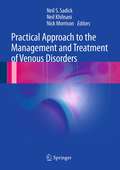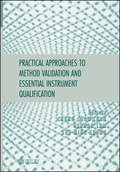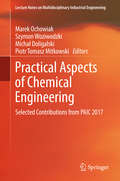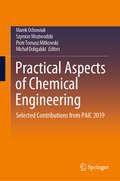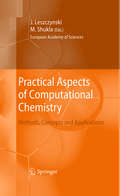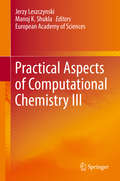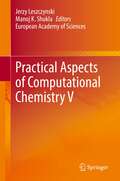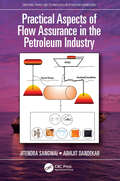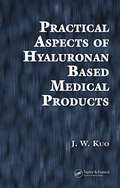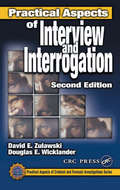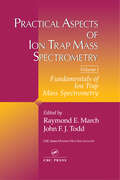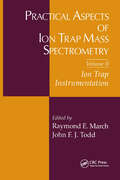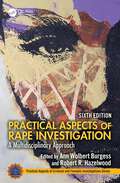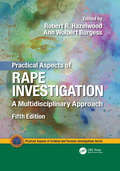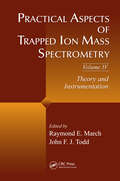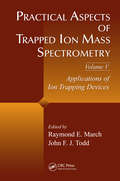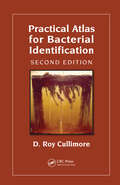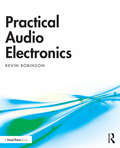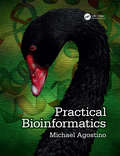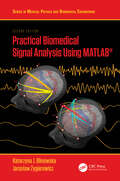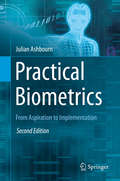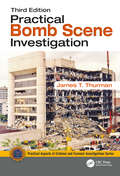- Table View
- List View
Practical Approach to the Management and Treatment of Venous Disorders
by Neil S. Sadick Nick Morrison Neil KhilnaniThis text evolved as a response to numerous requests to present a simplified approach to the diagnosis and management of most of the common aspects of both cosmetic and medical venous disorders. The authors, representing experienced plebologists from several different primary disciplines, have attempted to present simplistic paradigm-oriented approaches on how to thoughtfully evaluate and manage common vein issues with contemporary solutions. Several areas of phlebology were not addressed in this text. The management of vascular malformations are beyond the scope of this text and were not covered in detail. Although indications for the appropriate use of IVC filters are discussed, the details about the specific devices, their placement and removal are also beyond the scope of this text. Deep venous obstruction from prior thrombosis, venous compression by arteries such as the compression of the left common iliac vein by the right common iliac artery and pelvic venous insufficiency can now be managed with minimally invasive image guided treatments; the technical aspects of such treatments are complex and not discussed in detail in this handbook. This book will increase the therapeutic skill of the practicing phlebologist and thus increase the quality of care for patients faced with problems related to venous disorders.
Practical Approaches to Method Validation and Essential Instrument Qualification
by Xue-Ming Zhang Herman Lam Chung Chow ChanPractical approaches to ensure that analytical methods and instruments meet GMP standards and requirements Complementing the authors' first book, Analytical Method Validation and Instrument Performance Verification, this new volume provides coverage of more advanced topics, focusing on additional and supplemental methods, instruments, and electronic systems that are used in pharmaceutical, biopharmaceutical, and clinical testing. Readers will gain new and valuable insights that enable them to avoid common pitfalls in order to seamlessly conduct analytical method validation as well as instrument operation qualification and performance verification. Part 1, Method Validation, begins with an overview of the book's risk-based approach to phase appropriate validation and instrument qualification; it then focuses on the strategies and requirements for early phase drug development, including validation of specific techniques and functions such as process analytical technology, cleaning validation, and validation of laboratory information management systems Part 2, Instrument Performance Verification, explores the underlying principles and techniques for verifying instrument performance--coverage includes analytical instruments that are increasingly important to the pharmaceutical industry, such as NIR spectrometers and particle size analyzers--and offers readers a variety of alternative approaches for the successful verification of instrument performance based on the needs of their labs At the end of each chapter, the authors examine important practical problems and share their solutions. All the methods covered in this book follow Good Analytical Practices (GAP) to ensure that reliable data are generated in compliance with current Good Manufacturing Practices (cGMP). Analysts, scientists, engineers, technologists, and technical managers should turn to this book to ensure that analytical methods and instruments are accurate and meet GMP standards and requirements.
Practical Aspects of Chemical Engineering: Selected Contributions from PAIC 2017 (Lecture Notes on Multidisciplinary Industrial Engineering)
by Michał Doligalski Marek Ochowiak Szymon Woziwodzki Piotr Tomasz MitkowskiThis book focuses on Chemical Engineering and Processing, covering interdisciplinary innovation technologies and sciences closely related to chemical engineering, such as computer image analysis, modelling and IT. The book presents interdisciplinary aspects of chemical and biochemical engineering interconnected with process system engineering, process safety and computer science.
Practical Aspects of Chemical Engineering: Selected Contributions from PAIC 2019 (Lecture Notes On Multidisciplinary Industrial Engineering Ser.)
by Michał Doligalski Marek Ochowiak Szymon Woziwodzki Piotr Tomasz MitkowskiThis book discusses chemical engineering and processing, presenting selected contributions from PAIC 2019. It covers interdisciplinary technologies and sciences, like drug-delivery systems, nanoscale technology, environmental control, modelling and computational methods. The book also explores interdisciplinary aspects of chemical and biochemical engineering interconnected with process system engineering, process safety and computer science.
Practical Aspects of Computational Chemistry
by Jerzy Leszczynski Manoj Shukla"Practical Aspects of Computational Chemistry" presents contributions on a range of aspects of Computational Chemistry applied to a variety of research fields. The chapters focus on recent theoretical developments which have been used to investigate structures and properties of large systems with minimal computational resources. Studies include those in the gas phase, various solvents, various aspects of computational multiscale modeling, Monte Carlo simulations, chirality, the multiple minima problem for protein folding, the nature of binding in different species and dihydrogen bonds, carbon nanotubes and hydrogen storage, adsorption and decomposition of organophosphorus compounds, X-ray crystallography, proton transfer, structure-activity relationships, a description of the REACH programs of the European Union for chemical regulatory purposes, reactions of nucleic acid bases with endogenous and exogenous reactive oxygen species and different aspects of nucleic acid bases, base pairs and base tetrads.
Practical Aspects of Computational Chemistry I: An Overview of the Last Two Decades and Current Trends
by Jerzy Leszczynski Manoj K. K. ShuklaPractical Aspects of Computational Chemistry I: An Overview of the Last Two Decades and Current Trends gathers the advances made within the last 20 years by well-known experts in the area of theoretical and computational chemistry and physics. The title itself reflects the celebration of the twentieth anniversary of the “Conference on Current Trends in Computational Chemistry (CCTCC)” to which all authors have participated and contributed to its success. This volume poses (and answers) important questions of interest to the computational chemistry community and beyond. What is the historical background of the “Structural Chemistry”? Is there any way to avoid the problem of intruder state in the multi-reference formulation? What is the recent progress on multi-reference coupled cluster theory? Starting with a historical account of structural chemistry, the book focuses on the recent advances made in promising theories such as many body Brillouin-Wigner theory, multireference state-specific coupled cluster theory, relativistic effect in chemistry, linear and nonlinear optical properties of molecules, solution to Kohn-Sham problem, electronic structure of solid state materials, development of model core potential, quantum Monte Carlo method, nano and molecular electronics, dynamics of photodimerization and excited states, intermolecular interactions, hydrogen bonding and non-hydrogen bonding interactions, conformational flexibility, metal cations in zeolite catalyst and interaction of nucleic acid bases with minerals. Practical Aspects of Computational Chemistry I: An Overview of the Last Two Decades and Current Trends is aimed at theoretical and computational chemists, physical chemists, materials scientists, and particularly those who are eager to apply computational chemistry methods to problem of chemical and physical importance. This book will provide valuable information to undergraduate, graduate, and PhD students as well as to established researchers.
Practical Aspects of Computational Chemistry II
by Jerzy Leszczynski Manoj ShuklaPractical Aspects of Computational Chemistry II: An Overview of the Last Two Decades and Current Trends gathers the discussion of advances made within the last 20 years by well-known experts in the area of theoretical and computational chemistry and physics. The title reflects the celebration of the twentieth anniversary of the "Conference on Current Trends in Computational Chemistry (CCTCC)" to success of which all authors contributed. Starting with the recent development of modeling of solvation effect using the Polarizable Continuum Model (PCM) at the Coupled-Cluster level and the effects of extreme pressure on the molecular properties within the PCM framework, this volume focuses on the association/dissociation of ion pairs in binary solvent mixtures, application of graph theory to determine the all possible structures and temperature-dependent distribution of water cluster, generalized-ensemble algorithms for the complex molecular simulation, QM/MD based investigation of formation of different nanostructures under nonequilibrium conditions, quantum mechanical study of chemical reactivity of carbon nanotube, covalent functionalization of single walled-carbon nanotube, designing of functional materials, importance of long-range dispersion interaction to study nanomaterials, recent advances in QSPR/QSAR analysis of nitrocompounds, prediction of physico-chemical properties of energetic materials, electronic structure and properties of 3d transition metal dimers, the s-bond activation reactions by transition metal complexes, theoretical modeling of environmental mercury depletion reaction, organolithium chemistry and computational modeling of low-energy electron induced DNA damage. Practical Aspects of Computational Chemistry II: An Overview of the Last Two Decades and Current Trends is aimed at theoretical and computational chemists, physical chemists, materials scientists, and particularly those who are eager to apply computational chemistry methods to problems of chemical and physical importance. This book provides valuable information to undergraduate, graduate, and PhD students as well as to established researchers. Practical Aspects of Computational Chemistry II: An Overview of the Last Two Decades and Current Trends is aimed at theoretical and computational chemists, physical chemists, materials scientists, and particularly those who are eager to apply computational chemistry methods to problems of chemical and physical importance. This book provides valuable information to undergraduate, graduate, and PhD students as well as to established researchers.
Practical Aspects of Computational Chemistry IV
by Jerzy Leszczynski Manoj K. ShuklaThe editors of this volume have compiled an important book that is a useful vehicle for important computational research - in the development of theoretical methodologies and their practical applications. Themes include new methodologies, state-of-the-art computational algorithms and hardware as well as new applications. This volume, Practical Aspects of Computational Chemistry IV, is part of a continuous effort by the editors to document recent progress made by eminent researchers. Most of these chapters have been collected from invited speakers from the annual international meeting: "Current Trends in Computational Chemistry" organized by Jerzy Leszczynski, one of the editors of the current volume. This conference series has become an exciting platform for eminent Theoretical/Computational Chemists to discuss their recent findings and is regularly honored by the presence of Nobel laureates. Certainly, it is not possible to cover all topics related to the Computational Chemistry in a single volume but we hope that the recent contributions in the latest volume of this collection adequately highlight this important scientific area.
Practical Aspects of Computational Chemistry V
by Jerzy Leszczynski Manoj K. ShuklaThis book presents contributions on a wide range of computational research applied to fields ranging from molecular systems to bulk structures. This volume highlights current trends in modern computational chemistry and discusses the development of theoretical methodologies, state-of-the-art computational algorithms and their practical applications. This volume is part of a continuous effort by the editors to document recent advances by prominent researchers in the area of computational chemistry. Most of the chapters are contributed by invited speakers and participants to International annual conference “Current Trends in Computational Chemistry”, organized by Jerzy Leszczynski, one of the editors of the current volume. This conference series has become an exciting platform for eminent theoretical and computational chemists to discuss their recent findings and is regularly honored by the presence of Nobel laureates. Topics covered in the book include reactive force-field methodologies, coarse-grained modeling, DNA damage radiosensitizers, modeling and simulation of surfaces and interfaces, non-covalent interactions, and many others. The book is intended for theoretical and computational chemists, physical chemists, material scientists and those who are eager to apply computational chemistry methods to problems of chemical and physical importance. It is a valuable resource for undergraduate, graduate and PhD students as well as for established researchers.
Practical Aspects of Flow Assurance in the Petroleum Industry (Emerging Trends and Technologies in Petroleum Engineering)
by Jitendra Sangwai Abihijit DandekarWith easily accessible oil reserves dwindling, petroleum engineers must have a sound understanding of how to access technically challenging resources, especially in the deepwater environment. These technically challenging resources bring with them complexities around fluid flow not normally associated with conventional production systems, and engineers must be knowledgeable about navigating these complexities. Practical Aspects of Flow Assurance in the Petroleum Industry aims to provide practical guidance on all aspects of flow assurance to offer readers a ready reference on how to ensure uninterrupted transport of processed fluids throughout the flow infrastructure by covering all practical aspects of flow assurance, being written in such a way that any engineer dealing with the oil and gas industry will be able to understand the material, containing solved examples on most topics, placing equal emphasis on experimental techniques and modeling methods, and devoting an entire chapter to the analysis and interpretation of published case studies. With its balance of theory and practical applications, this work provides petroleum engineers from a variety of backgrounds with the information needed to maintain and enhance productivity.
Practical Aspects of Hyaluronan Based Medical Products
by J.W. KuoThe ballooning body of research devoted to hyaluronan (HA) reflects its enormous potential for various medical applications. There have been many successes of varying degrees in the development of medical products based on HA, but also some setbacks. While there is obviously ample information available on the chemistry and various properties of thi
Practical Aspects of Interview and Interrogation (ISSN)
by Shane G. Sturman L. Wayne Hoover David E. Zulawski Douglas E. WicklanderBuilding on the foundation of the bestselling first edition, Practical Aspects of Interview and Interrogation, Second Edition expands its coverage to include discussions of false confessions, telephone interviewing, field interviewing, sexual harassment interviewing, confronting the alleged harasser, pre-employment interviewing, new legal aspects, juvenile interviewing, common mistakes, and frequently asked questions. Useful in both the law enforcement and private sectors, this work allows readers to deal effectively with the complex problems of interviewing and interrogating victims, witnesses, suspects, and even prospective employees.
Practical Aspects of Ion Trap Mass Spectrometry, Volume I
by March Raymond E. Todd John F. J.Fundamentals of Ion Trap Mass Spectrometry presents an account of the development and theory of the quadrupole ion trap and its utilization as an ion storage device, a reactor for ion/molecular reactions, and a mass spectrometer. It also expands the appreciation of ion traps from that of a unique arrangement of electrodes of hyperbolic form (and having a pure quadrupole field) to a series of ion traps having fields with hexapole and octopole components and introduces the practical ion trapping device in which electrode spacing has been increased.The fundamentals of ion trap are covered in four chapters, beginning with the origin of the ion trap, its development and operating principles, and improvements in performance. The second part focuses on the environment within the ion trap -- the movement of ions within the trap -- and how this movement is modified by repeated collisions of the ions with buffer gas atoms of helium, and on the collisions of ions with molecules that lead to chemical change. The critical role of collisions in focusing the ion cloud for subsequent operations is emphasized. This important reference presents a coherent picture of the present status of research in the ion trapping field to facilitate the entree of potential ion trappers and provide a backdrop for ion trap research and development in the future.
Practical Aspects of Ion Trap Mass Spectrometry, Volume II
by Raymond E. March Todd, John F. J.By delivering concentrated information in three different volumes, the editors of the Practical Aspects of Ion Trap Mass Spectrometry mini-series present in-depth reviews on mainstream developments in each active and popular area. Contributing authors provide concise reports illustrating successful approaches to difficult analytical problems across the basic scientific disciplines.Ion Trap Instrumentation, the second volume in the series, conveys an appreciation of the ion trap as a versatile instrument which is used successfully in research and in applications, often in tandem with other instruments or components, such as external ion sources and lasers.The book begins with a discussion of high resolution mass spectrometry and mass measurement accuracy. It then demonstrates that trajectories of high kinetic energy ions can be controlled so that such ions are confined. It provides applications of lasers to the study of trapped ions the laser photodissociation of gaseous ions confined within the ion trap. The book concludes with physics applications of the ion trap, in particular, the Penning trap and the Paul trap.
Practical Aspects of Rape Investigation: A Multidisciplinary Approach, (Practical Aspects of Criminal and Forensic Investigations)
by Robert R. Hazelwood Ann BurgessThe latest sixth edition of Practical Aspects of Rape Investigation is a fully updated, comprehensive volume on investigative procedures and victim-oriented case management for professionals assisting victims of rape and sexual assault.Rape and sexual assault cases have a devastating societal impact, particularly among the vulnerable populations most affected, including women, children, the elderly, minorities, and members of the LGBTQ+ communities. Such cases are all too common and, unfortunately, the number of cases continues to rise. As such, the need for a current reference on the topic has never been more pressing.Edited by Ann Wolbert Burgess—the subject of Hulu’s 2024 documentary series Mastermind: To Think Like a Killer, and an internationally recognized researcher and pioneer in the assessment and treatment of victims of trauma and abuse—this book covers various topics contributed to by experts from a broad range of fields. Leading academics, researchers, and investigative professionals address the problem of rape and sexual assault holistically, focusing on the core principles of real-world investigative techniques, behavioral profiling, investigative strategies and techniques, social worker involvement, and victimology.When a rape case goes undetected or unreported, a violent offender remains on the streets with the opportunity to reoffend—often repeatedly. Because victims are frequently reluctant to speak out or act in such cases, this book aims to raise awareness and, ultimately, decrease the number of silent victims and improve rape-investigative capabilities and outcomes.Practical Aspects of Rape Investigation, Sixth Edition provides the essential tools and techniques for professionals to best serve, and advocate for, victims. It continues to serve as an invaluable reference for students, legal professionals, and case managers, and as a blueprint for investigators and law enforcement professionals on case management best practices.
Practical Aspects of Rape Investigation: A Multidisciplinary Approach, Fifth Edition (Practical Aspects of Criminal and Forensic Investigations)
by Ann Wolbert Burgess Robert R. HazelwoodThis latest edition addresses rape and sexual assaults from all clinical, pathological, medical, and legal aspects. The book focuses on the victim and covers contemporary issues in sexual violence, investigative aspects of rape and sexual assault, offender fantasy, the personality of the offender, collection of evidence, medical examinations, and treatment, as well as trial preparation issues. Special topics include pedophiles, female and juvenile offenders, drug-facilitated rape, sexual sadism, elder abuse, and sexual assault within the military.
Practical Aspects of Trapped Ion Mass Spectrometry, Volume IV: Theory and Instrumentation
by Raymond E. March John F. J. ToddReflecting the substantial increase in popularity of quadrupole ion traps and Fourier transform ion cyclotron resonance (FT-ICR) mass spectrometers, Practical Aspects of Trapped Ion Mass Spectrometry, Volume IV: Theory and Instrumentation explores the historical origins of the latest advances in this expanding field. It covers new methods for trapp
Practical Aspects of Trapped Ion Mass Spectrometry, Volume V: Applications of Ion Trapping Devices
by Raymond E. March John F. J. ToddWidely used in medical research, pharmaceutical and fine chemicals industries, biological and physical sciences, and security and environmental agencies, mass spectrometry techniques are continually under development. In Practical Aspects of Trapped Ion Mass Spectrometry: Volume V, Applications of Ion Trapping Devices, an international panel of aut
Practical Astronomy with your Calculator or Spreadsheet
by Peter Duffett-Smith Jonathan ZwartNow in its fourth edition, this highly regarded book is ideal for those who wish to solve a variety of practical and recreational problems in astronomy using a scientific calculator or spreadsheet. Updated and extended, this new edition shows you how to use spreadsheets to predict, with greater accuracy, solar and lunar eclipses, the positions of the planets, and the times of sunrise and sunset. Suitable for worldwide use, this handbook covers orbits, transformations and general celestial phenomena, and is essential for anyone wanting to make astronomical calculations for themselves. With clear, easy-to-follow instructions for use with a pocket calculator, shown alongside worked examples, it can be enjoyed by anyone interested in astronomy, and will be a useful tool for software writers and students studying introductory astronomy. High-precision spreadsheet methods for greater accuracy are available at www. cambridge. org/practicalastronomy.
Practical Atlas for Bacterial Identification
by D. Roy CullimorePublished nearly ten years ago, the first edition of Practical Atlas for Bacterial Identification broke new ground with the wealth of detail and breadth of information it provided. The second edition is poised to do the same. Differing fundamentally from the first edition, this book begins by introducing the concept of bacteria community intelligen
Practical Audio Electronics
by Kevin RobinsonPractical Audio Electronics is a comprehensive introduction to basic audio electronics and the fundamentals of sound circuit building, providing the reader with the necessary knowledge and skills to undertake projects from scratch. Imparting a thorough foundation of theory alongside the practical skills needed to understand, build, modify, and test audio circuits, this book equips the reader with the tools to explore the sonic possibilities that emerge when electronics technology is applied innovatively to the making of music. Suitable for all levels of technical proficiency, this book encourages a deeper understanding through highlighted sections of advanced material and example projects including circuits to make, alter, and amplify audio, providing a snapshot of the wide range of possibilities of practical audio electronics. An ideal resource for students, hobbyists, musicians, audio professionals, and those interested in exploring the possibilities of hardware-based sound and music creation.
Practical Bioinformatics
by Michael AgostinoPractical Bioinformatics is specifically designed for biology majors, with a heavy emphasis on the steps required to perform bioinformatics analysis to answer biological questions. It is written for courses that have a practical, hands-on element and contains many exercises (for example, database searches, protein analysis, data interpretation) to
Practical Biomedical Signal Analysis Using MATLAB® (Series in Medical Physics and Biomedical Engineering)
by Katarzyna J. Blinowska Jarosław ŻygierewiczCovering the latest cutting-edge techniques in biomedical signal processing while presenting a coherent treatment of various signal processing methods and applications, this second edition of Practical Biomedical Signal Analysis Using MATLAB® also offers practical guidance on which procedures are appropriate for a given task and different types of data. It begins by describing signal analysis techniques—including the newest and most advanced methods in the field—in an easy and accessible way, illustrating them with Live Script demos. MATLAB® routines are listed when available, and freely available software is discussed where appropriate. The book concludes by exploring the applications of the methods to a broad range of biomedical signals while highlighting common problems encountered in practice. These chapters have been updated throughout and include new sections on multiple channel analysis and connectivity measures, phase-amplitude analysis, functional near-infrared spectroscopy, fMRI (BOLD) signals, wearable devices, multimodal signal analysis, and brain-computer interfaces. By providing a unified overview of the field, this book explains how to integrate signal processing techniques in biomedical applications properly and explores how to avoid misinterpretations and pitfalls. It helps readers to choose the appropriate method as well as design their own methods. It will be an excellent guide for graduate students studying biomedical engineering and practicing researchers in the field of biomedical signal analysis. Features: Fully updated throughout with new achievements, technologies, and methods and is supported with over 40 original MATLAB Live Scripts illustrating the discussed techniques, suitable for self-learning or as a supplement to college courses Provides a practical comparison of the advantages and disadvantages of different approaches in the context of various applications Applies the methods to a variety of signals, including electric, magnetic, acoustic, and optical Katarzyna J. Blinowska is a Professor emeritus at the University of Warsaw, Poland, where she was director of Graduate Studies in Biomedical Physics and head of the Department of Biomedical Physics. Currently, she is employed at the Institute of Biocybernetics and Biomedical Engineering of the Polish Academy of Sciences. She has been at the forefront in developing new advanced time-series methods for research and clinical applications. Jarosław Żygierewicz is a Professor at the University of Warsaw, Poland. His research focuses on developing methods for analyzing EEG and MEG signals, brain-computer interfaces, and applications of machine learning in signal processing and classification.
Practical Biometrics
by Julian AshbournThis practically-focused text presents a hands-on guide to making biometric technology work in real-life scenarios. Extensively revised and updated, this new edition takes a fresh look at what it takes to integrate biometrics into wider applications. An emphasis is placed on the importance of a complete understanding of the broader scenario, covering technical, human and implementation factors. This understanding may then be exercised through interactive chapters dealing with educational software utilities and the BANTAM Program Manager. Features: provides a concise introduction to biometrics; examines both technical issues and human factors; highlights the importance of a broad understanding of biometric technology implementation from both a technical and operational perspective; reviews a selection of freely available utilities including the BANTAM Program Manager; considers the logical next steps on the path from aspiration to implementation, and looks towards the future use of biometrics in context.
Practical Bomb Scene Investigation (Practical Aspects of Criminal and Forensic Investigations)
by James T. ThurmanNow in its Third Edition, Practical Bomb Scene Investigation explores the investigative process that improvised explosive device (IED) specialists undertake at the scene of an explosion. Providing easy-to-understand, step-by-step procedures for managing and processing a bomb scene, it enables investigators to find the evidence and then make sense of what is found. The book is not only a roadmap on how to find and collect evidence and assess the scene, but also provides instruction on identifying the bombmaker's signature through latent print, DNA, explosive residue, metallurgical, and toolmark examination and forensic analysis.
